
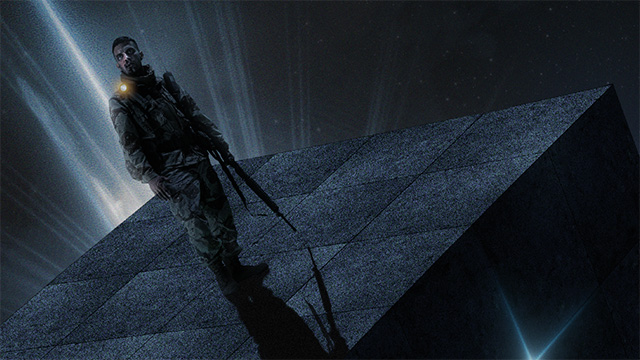
Saturday February 5, 2022 | Buckners reviews | Neal
The Abandon (2022) – a feature film review by Andrew Buckner
Premiering Sunday at Mammoth Film Festival
MammothFilmFestival.org
A wounded soldier, Miles Willis (Jonathan Rosenthal), awakens in a strange grey room. Initially thinking the place is a hospital, he finds the phrase “abandon all hope” scrawled on a wall. Suffering from sudden shifts in the region which suddenly hurl him from one side of the area to the next, even more sinister clues as to where he is and what is going on quickly unfurl. After unexpected contact with a stranger, Damsey Robins (Tamara Perry), the duo must band together to solve the mystery of their mentally and physically demanding predicament in hopes of survival.
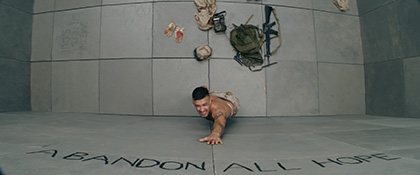
Such is the plot of The Abandon (2022), from writer Dwain Worrell and director Jason Satterlund, which plays like a war-rooted variation on Vincenzo Natali’s Cube (1997) and James Wan’s Saw (2004) with an elemental peppering of Darren Aronofsky’s brilliant Pi (1998). The 97-minute movie holds too rigorously to the incidents, ingredients, and revelations that have become commonplace in ventures such as these to be as groundbreaking as these comparative items from which it draws inspiration. Regardless, it sets up its concept nicely within its first five minutes. From herein, the effort is tremendously successful as a demonstration of “race against the clock” style suspense that is deftly implemented and sustained until the end credits. It is nearly as good at teasing the enigma at the heart of the story. Though it comes with some obvious yet still entertaining twists in the satisfying final act, this cryptic component brings about a variety of time-tested yet still intriguing science-fiction-based ideas in the later stretches. Though what is ultimately revealed isn’t particularly unique or memorable, the journey to this place is certainly enthralling and worthwhile.
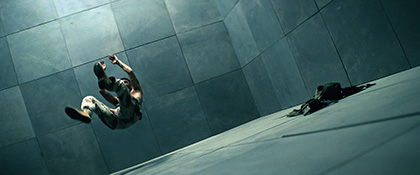
The project is at its best in its increasingly compelling second half. In this section, the undertaking adds new dangers, stakes, and intimate and emotional character-driven moments to the narrative. What further benefits this portion is that these aspects are delivered in an even-handed and organic manner. Still, the exercise is noteworthy for being briskly paced and focused on tale telling throughout the entirety of the duration. It is just as significant to mention that this division introduces welcome touches of political and social commentary. These facets are utilized without overwhelming spectators with its presence or feeling out of place.
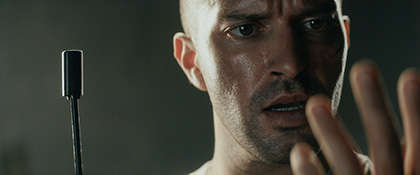
Likewise, the enterprise is just as commendable for its top-notch performance from Rosenthal. He fashions Willis into a credible, layered, and easy to root for lead. Thus, the mostly one-man-in-a-single-location approach to the material is far richer, tense, and more involving. The enactment from Perry as Robins is also accomplished and effective. She skillfully conveys a bevy of sentiments, including anxiety and concern, through the only way viewers know her through most of the excursion: her voice.
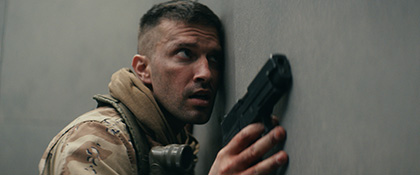
What is just as well-done are the opening scenes of combat and the topically related concluding segments. Many of the visual mechanisms, such as the effects and camera work, are generally strong. This is with the previously stated sequences of random interior movement, as well as some slow-motion bits which are usually associated with these instances, being the rare acceptance to this statement. Yet, the opus defeats these slight faults with sharp, clean cinematography from Ray Huang. This attribute beautifully strengthens and fits the masterfully rendered, claustrophobic tone of the piece. Even the vicinity Willis finds himself imprisoned within is a quietly awe-inspiring testament to the power of the sleek set design found herein.
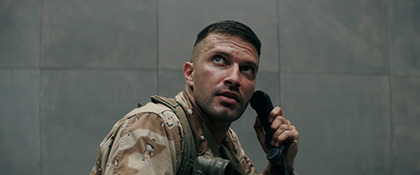
Confidently guided behind the lens by Satterlund and penned with just the right amount of development from its two central figures and a knack for realistic dialogue by Worrell, The Abandon is garden variety in structure. Nonetheless, it encourages audiences to imagine what might be transpiring outside of Willis’ ever-cramped world. The fruitfulness of this detail, as well as the sly sequel setup, wonderfully balance out this trait. The cinematic contribution is also admirable as a triumph in the categories of sound, music, makeup, and editing. Moreover, the endeavor boasts superb secondary turns from Dan Kyle as Dorian and Regis Terencio as Foreign Caller. Released with the assistance of the production company Mill House Motion Pictures and shot in Spokane, Washington, the construction is robust in its handling of the theme of confronting the sins of the past. In so doing, Satterlund has woven a taut, intelligent thriller that nimbly overcomes its conventional trappings.
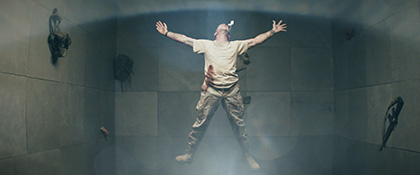
The Abandon receives ***1/2 out of ***** on The Buckner Scale.